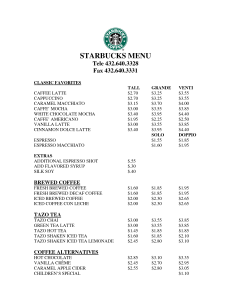Starbucks Coffee prints a motto on the back of their business cards: “One person, one cup, and one neighborhood at a time.” If you read it carefully, it sounds a bit like the credo of an Alien nation about to invade Earth.
For the record, Seattle is a nice town, or at least when the smog is not creating total overcast. The Space Needle is spectacular and Grey’s Anatomy is not a bad show, all things being considered. So any opinions I may have regarding Starbucks and its policies are no reflection on Seattle in general.
Starbucks is a mega-corporation, opening new franchises in every major community, with stores often in shouting distance from one another. Fort Lee is endowed with two branches, where battery acid is sold for approximately $ 2.00 per cup and baked goods are sold for $ 1.95 to $ 2.25 per item. Frappuccinos and Cappuccinos are sold for $ 4.00+. Coffee is sold by the pound for $11.95 and tea is sold for $ 4.95 per box. “Starbucks Logo merchandise” is pandered, where the public can advertise the brand by purchasing an overpriced cup, a thermos, a T-Shirt or a hat. Coffee grinders and coffee machines are on sale for premium prices. They even carry CDs for your car stereos.
The bottom line is that “STARBUCKS MINTS MONEY”. And from the massive crowds in the morning and evening at the Whiteman Plaza branch and the Linwood Plaza branch, it is my suspicion that these two Starbucks are extremely successful , ranking with top grossing Starbucks stores around the nation.
I recently approached the store manager, Alysa Yeager, at the Whiteman Plaza branch and requested that Starbucks make a small cash donation to a fundraising campaign for the Fort Lee school children. Alysa reluctantly took my information, informing me that she had to speak to “corporate”. Three weeks later I returned, whereupon Alysa informed me that she had been too busy to speak to corporate, but she was sure that it was Starbucks policy “not to advertise locally” or to “make cash donations” to the community. I requested that she check with “corporate” to verify that and to please get back to me, i.e. I would return in a few days. On Monday, July 15, I returned and Alysa stated that cash donations violated company policy, but that I could speak to her superior.
Upon returning to my office, I called Corporate Headquarters in Seattle and spoke to Veronica Park, whose title on her business card was listed as “Coffee Master”. I am uncertain where “coffee master” ranks in the Starbucks hierarchy, but the title is almost comical in its lack of creativity. One might extrapolate that the corporate execs probably call the hard working, lower level employees of each Starbucks “coffee grinds”.
Ms. Park was very cordial and pleasant, while she read to me from her corporate script. To paraphrase Ms. Park, “Starbucks has a corporate policy where local managers may donate two pounds of coffee per month locally. We also will contribute coffee to any local charitable fundraisers. Finally, we have a community program where our employees are encouraged to volunteer to do community service with a $ 10 compensation”. (I am uncertain if this was $ 10 per hour, but it is totally irrelevant.) I explained to her that (1) two pounds of coffee per month costs them less than $ 10 and that my friends and I spend far more than that each week at the Whiteman Plaza location; (2) coffee donations to a few fundraisers per year were at minimal cost; and (3) that the community service program was more PR than an actual benefit. Our conversation concluded rather abruptly when I decided that enough time had been wasted on what was clearly a dead end.
The Whiteman Plaza Starbucks is frequented by high school kids and parents dropping their children off at School #1 in the morning. The Linwood Plaza Starbucks is heavily supported by high school kids and parents droppings kids off at Fort Lee High School and School #3. Is it asking so much for a few hundred dollars to help our kids? Apparently so.
In fundraising efforts to benefit the children of Fort Lee, local businesses have been extremely generous. Delis and restaurants, local business people, doctors and lawyers, banks, etc. have all contributed. We have raised several thousand dollars for the children, but not one dime was contributed from Starbucks. So unless we plan on having a celebratory party for the donors, where we serve coffee (but no more than two pounds), we had better not depend on Starbucks to support our kids.
It should be clear that the criticism of Starbucks is not that they are doing nothing, but that they are financially capable of doing so much more. Our kids need textbooks and computers, lab equipment, and new desks. Our sports teams need new uniforms and equipment. We have a high school field in total disrepair, with a running track that needs to be totally replaced. We have buildings that need major upgrades as well as new classrooms. And Starbucks wants to donate a few pounds of coffee. A company as powerful as Starbucks has the ability to remedy so many of the deficiencies in the schools. But the “corporate credo” is no cash donations to the community, while it counts its vast profits from the Fort Lee franchises.(Google: Wikipedia.org: the net worth of Howard Schultz, chairman and CEO of Starbucks is an estimated $1.5 billion.)
So, next time, before plopping down a $10 bill to buy a few overpriced frappuccinos at Starbucks in Fort Lee or to buy a “Starbucks” cup to advertise their products, maybe we should reconsider whether we want to spend our hard earned money supporting a billion dollar corporation that contributes very little to local communities.

